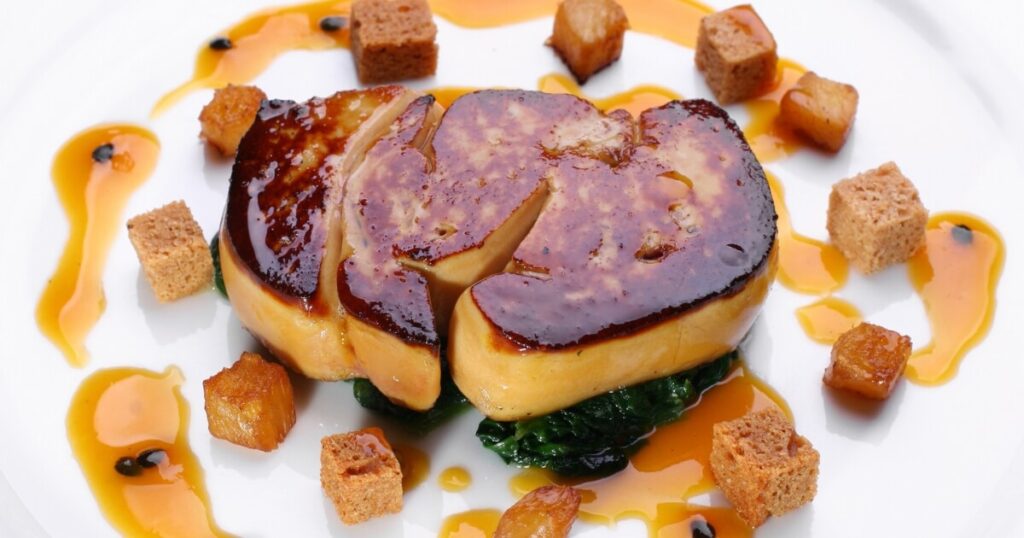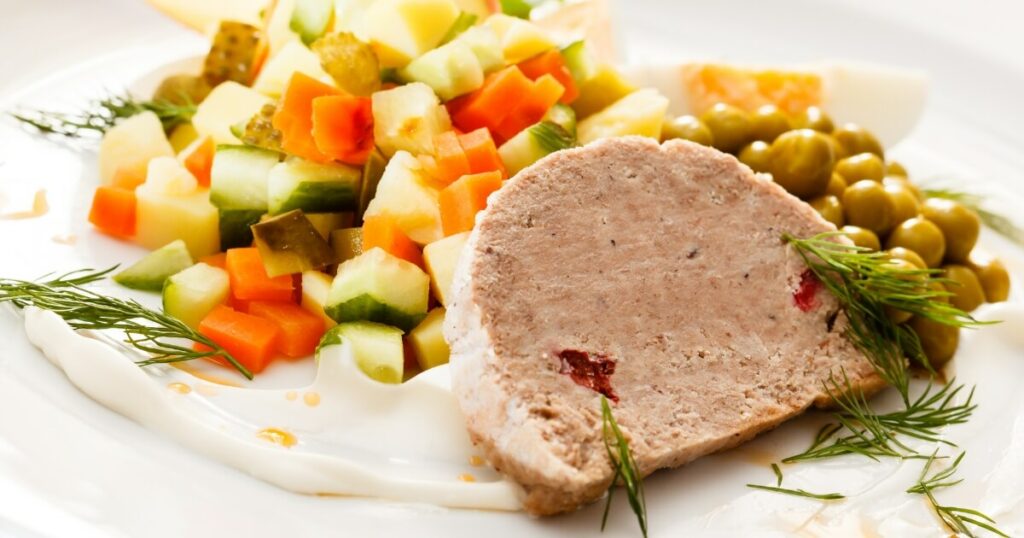Today, we will chat about a real game-changer in the kitchen, foie gras.
Now, I know what you’re thinking, “Isn’t that a fancy French thing?” Yes, it is, but don’t let that intimidate you.
Foie gras is made from the livers of a duck or goose. It’s a rich, buttery delight that can add luxury to your everyday meals.
In this article, you will discover the taste of foie gras, how it can vary depending on the type and preparation, and why understanding these nuances is so important.
How Does Foie Gras Taste?
The initial taste is rich and buttery, almost like a decadent cream. This richness is balanced by a delicate sweetness that’s not overpowering but just enough to tantalize your taste buds.

The texture is one of the highlights of foie gras. It’s incredibly smooth and creamy, and it melts in your mouth, leaving a lingering, utterly satisfying taste.
The aroma of foie gras is subtly earthy, which complements its rich flavor. It’s not a strong smell but it adds another layer to the overall experience of eating foie gras.
Now, the taste of foie gras can vary depending on a few factors. For instance, duck foie gras tends to have a slightly gamey flavor compared to goose foie gras, which is a bit more delicate.
The method of preparation will also influence the taste of foie gras. When it’s pan-seared, the outside becomes crispy, adding a delightful contrast to the creamy interior.
On the other hand, when used in a terrine or a mousse, the taste is more uniform, allowing the rich, buttery flavor of the foie gras to shine.
What Does Foie Gras Compare With?
- Butter: The rich, creamy texture of foie gras is often compared to high-quality butter. Just like butter, it melts in your mouth and leaves a velvety feel on your palate.
- Pâté: Foie gras has a similar consistency to pâté, especially when it’s prepared as a mousse or terrine. However, foie gras has a more refined and complex flavor.
- Truffles: In terms of its luxurious feel and complex flavor profile, foie gras is often compared to truffles. Both are considered gourmet ingredients that can elevate a dish.
- Avocado: While the taste is quite different, the creamy, melt-in-your-mouth texture of foie gras can be compared to a perfectly ripe avocado.
- Duck or Goose Meat: Foie gras comes from the liver of a duck or goose, so it’s not surprising that it shares some flavor characteristics with duck or goose meat. However, foie gras is much richer and more delicate in flavor.
Does Foie Gras Taste Good?
If you enjoy rich, buttery flavors and a creamy, melt-in-your-mouth texture, then you’ll likely find foie gras to be absolutely delicious.
It’s a luxurious ingredient that can make a dish feel special and indulgent. The complex flavor profile is both delicate and intense.
On the other hand, if you’re not a fan of fatty foods or prefer more straightforward flavors, foie gras might not be to your liking.
Its richness can be overwhelming for some, and the unique texture, while loved by many, is not for everyone.
Also, there’s an ethical aspect to consider. The making of foie gras involves force-feeding ducks or geese, a practice that has been criticized for its impact on animal welfare.
Some people choose not to eat foie gras because of these ethical concerns.
How To Make Foie Gras Taste Good
- Quality Matters: Start with high-quality foie gras. The taste of your final dish will heavily depend on the quality of the foie gras you use. Look for foie gras that is fresh and has a firm texture.
- Simple Seasoning: Foie gras has a rich, complex flavor that doesn’t require a lot of additional seasoning. A bit of salt and pepper is often enough to enhance its natural taste.
- Proper Cooking: Overcooking foie gras can make it tough and bitter. It should be cooked just until it’s lightly browned on the outside and still soft on the inside. If you’re pan-searing it, a couple of minutes on each side should do the trick.
- Pairing: Pair foie gras with something sweet or acidic to balance its richness. A spoonful of fruit compote, a drizzle of balsamic reduction, or a slice of toasted brioche can beautifully complement the taste of foie gras.
- Chill Before Cooking: If you’re pan-searing foie gras, make sure to chill it in the refrigerator before cooking. This helps it hold its shape better and prevents it from melting too quickly in the pan.
- Rest After Cooking: Just like a good steak, foie gras benefits from a little rest after it’s cooked. This allows the juices to redistribute, resulting in a more flavorful and enjoyable eating experience.
How To Eat Foie Gras
Pan-Seared Foie Gras

One of the most popular ways to enjoy foie gras is to pan-sear it. This method gives the foie gras a crisp exterior while keeping the inside soft and creamy.
It’s typically served with a sweet or acidic component, like a fruit compote or a balsamic reduction, to balance out its richness. A slice of toasted brioche on the side makes for a perfect bite.
Foie Gras Terrine
A terrine is another classic way to prepare foie gras. The foie gras is marinated, often in a sweet wine like Sauternes, then slow-cooked in a water bath and pressed to form a dense, creamy loaf.

It’s typically served chilled, sliced thin, and spread on crusty bread. A sprinkle of coarse sea salt on top can really make the flavors pop.
Foie Gras Mousse
For a lighter, more spreadable option, there’s foie gras mousse. This preparation involves puréeing cooked foie gras with cream and other flavorings until it’s silky smooth.
The mousse can be served chilled, spread on crackers or toast, or used as a filling for pastries or other dishes.
Foie Gras in Fine Dining
In fine dining, foie gras is often used to add a touch of luxury to a dish.
It can be incorporated into a sauce, used as a stuffing for meats or poultry, or even made into ice cream for a truly decadent dessert.
The key is to balance its rich flavor with other components of the dish.
Remember, foie gras is a rich ingredient, so a little goes a long way.
What Does Foie Gras Look Like?
Foie gras, in its raw form, is a large, lobed organ that has a pale, creamy color. It’s smooth and soft to the touch, with a firmness similar to a well-set custard’s.

The liver, which comes from a duck or goose, is significantly larger than a typical poultry liver due to the force-feeding process known as ‘gavage.’ This process results in a liver rich in fat, contributing to its unique flavor and texture.
When you cut into raw foie gras, you’ll notice that it has a dense, almost buttery texture.

It’s homogeneous in appearance, with a creamy, off-white color that can range from pale yellow to light pink.
The color can vary depending on the bird’s diet and the preparation method.
Once cooked, foie gras changes in appearance.
If it’s pan-seared, the outside turns a beautiful golden brown while the inside remains soft and creamy.
A well-cooked piece of foie gras should be crispy on the outside and melt-in-your-mouth tender on the inside.
In the form of a terrine or mousse, foie gras takes on a different appearance. A terrine is typically a rectangular loaf, while a mousse is often served in a jar or ramekin. Both are smooth and spreadable, with a uniform, creamy color.
Different Types Of Foie Gras
- Duck Foie Gras: This is the most common type of foie gras. It has a robust, slightly gamey flavor that’s balanced by its rich, buttery texture. Duck foie gras is often preferred for recipes that involve cooking, such as pan-searing because it holds its shape well.
- Goose Foie Gras: Goose foie gras is considered the more luxurious of the two. It has a more delicate flavor and a slightly smoother texture than duck foie gras. Its taste is less gamey and more refined, making it a favorite for dishes where it’s served raw or lightly cooked, like terrines or torchons.
Foie Gras FAQs
What is foie gras made of?
Foie gras is made from the livers of a duck or goose that have been specially fattened. This is typically achieved through a process known as ‘gavage,’ where the birds are force-fed corn to enlarge their livers.
Is foie gras ethical?
The production of foie gras is controversial due to the force-feeding process, which some people believe is cruel to the birds. However, some farmers use more humane methods to produce foie gras. It’s a complex issue with strong opinions on both sides.
Can you eat foie gras raw?
While foie gras is often cooked, it can also be eaten raw in certain preparations. For example, foie gras terrine is made from raw liver that’s been marinated and slow-cooked in a water bath. However, it’s important to consume from a trusted source if you’re going to eat it raw.
Why is foie gras so expensive?
Foie gras is expensive due to the labor-intensive process of producing it. The ducks or geese need to be carefully raised and fed, and the process of preparing and cooking the liver is also quite intricate. Furthermore, foie gras is considered a luxury product, which adds to its high price.
My Tasty Thoughts
As a home cook who loves experimenting with different ingredients, I understand that foie gras might not be for everyone.
Its richness can be overwhelming for some, and ethical considerations can deter others. But if you’re open to trying new flavors and textures, foie gras is worth a try.
One final tip for those of you who are ready to embark on your foie gras adventure: remember to savor each bite. Foie gras is not something to be rushed. Take your time to appreciate its complex flavor and luxurious texture. Trust me. It’s an experience you won’t forget.


